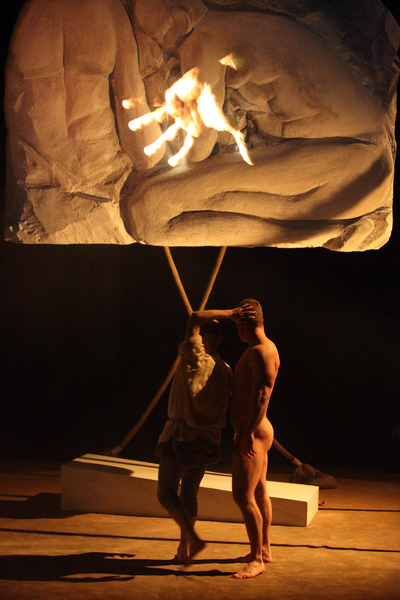Peter Reynolds reviews Michelangelo Drawing Blood as an impressive performance admiring it for its clear notes and the rich idea of composition.
The idea of composing music for long defunct instruments is not recent: Francis Poulenc and Manuel De Falla composed for the rediscovered harpsichord in the 1920s and the early music revival of the 1960s led to pieces such as Mauricio Kagel’s Music for Renaissance Instruments (1966). It is an idea that continues to intrigue composers and forms the basis of Michelangelo Drawing Blood, the latest production from Cardiff-based Sound Affairs, which received its second showing at the Sherman Theatre last week (following its premiere at the Malvern Theatre) before moving on to a further twelve performances at other venues.
It is not, though, a purely musical performance. To call Sound Affairs productions cross disciplinary is a polite way of describing the work of a company that has consistently thought ‘outside the box’. Yet music has always been a constant factor in their productions and, in the last ten years in particular, has been combined with a wide number of other genre. Recent productions have included music and silent film (Salome, 2010), African and Western instruments together with the visual arts (Afrodisiac, 2011), and music and dance (Boulevard of Broken Dreams, 2009).
Michelangelo Drawing Blood pulls together a number of different threads combining music (both live and recorded), dance, performance and film lasting around seventy minutes. At its core lies Michelangelo’s sketches for the unfinished fresco, The Battle of Cascina. Although aspects of this form the basis of the choreography, underlying musical structures and film, its use is not linear but ranges through a series of freely associative aspects of Michelangelo’s work and life. Structures emerge from ideas as divergent as camera obscura, chiaroscuro, texts from the Roman Catholic mass and Michelangelo’s own sonnets. An important element is drawn from Michelangelo’s idea (expressed in the 151st Sonnet) of ‘releasing a sculpture’ concealed within a block of marble, his own obsession with anatomy and his response to the male body.

Sherman Theatre,
Cardiff, 27th March 2013
This, and its relationship to the iconic figure of Michael is represented by the performer Stefano Giglioni, whose statuesque presence interacts with dancer Aaron Jeffrey, representing the figure of Michelangelo with choreography by Andy Howitt. The fluidity of Jeffery’s performance and his interaction with the more metaphorically unyielding Giglioni was not to everyone’s taste, but presented a pleasing contrast between the two ideas of the artist and the release of the sculpture. Film maker Barnaby Dicker’s contribution, projected onto a small screen immediately above the action, guided and produced atmospheric structural signposts to a piece of theatre, arguably too referentially rich for all the different strands to register after just one performance.
Michelangelo Drawing Blood is very much a collaboration between artists working in different media, but the central figure behind the concept and production is Cardiff-based composer and Artistic Director of Sound Affairs, Charlie Barber. At around seventy minutes in duration, his score for the production is a major piece of work utilising live instruments familiar to Renaissance musicians: theorbo, bass recorder and bass viol together with countertenor (the superbly honey-toned James Hall). These were complimented by timpani, percussion and a recorded quartet of trombones and choral music.
In the past, Barber’s recourse to pre-existing music as a starting point has led to the label ‘eclectic’, but scores of recent years have now revealed a personal and original music voice, effortlessly absorbing a wide range of cultural references. The music for Michelangelo Drawing Blood has a slow, meditative, burnished quality, whose seventeen sections are not without moments of excitement and passion. In the hard, unforgiving acoustic of the Sherman Theatre, there were balance problems for the live instrumentalists and the most pleasing way to hear this fascinating score might well turn out to be on the CD that Sound Affairs have produced to complement the performances.
This is a performance whose rich strands and cross-references ideally require a couple of performances to aid comprehension, though Maja Palser’s admirably clear notes in the programme go a long way towards charting the audience through many of the disparate elements at play. It is a considered and very impressive piece of work.
Michelangelo Drawing Blood tours between 25 April and 11 July to twelve venues in London, Manchester, Liverpool, Caernarfon, Cambridge, Spalding, Birmingham. Swansea. Brecon, Chester, Lichfield and Cheltenham. More details and the CD of the music are available from Sound Affairs’s website: www.soundaffairs.co.uk










